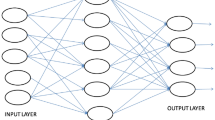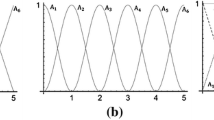Abstract
In the past few years, non-stochastic fuzzy time series (FTS) models have drawn remarkable attention of researchers from different domains. Unlike traditional stochastic models, FTS models do not require any strict assumption on the characteristics of data to be modeled and are applicable to time series even with uncertainty. However, the effectiveness of FTS models largely depends on the determination of effective length of interval and modeling of fuzzy logical relationships (FLRs). Motivated by this, in this paper, we have developed a novel method using fuzzy c-means clustering to determine the unequal-length of interval. Additionally, for the first-time membership values are considered while modeling the FLRs using support vector machine (SVM). The order of the model is determined by analyzing the autocorrelation function and partial autocorrelation function of the time series. To measure the accuracy of the proposed model, ten different time series datasets are considered. Four recently developed fuzzy time series forecasting models and two popular crisp time series forecasting models using MLP and SVM are considered for comparative performance analysis. From the experimental result analysis, it is observed that the proposed model outperforms other alternatives and shows statistically better forecasting accuracy based on the popular Wilcoxon signed-rank test; and Friedman and Nemenyi hypothesis test.













Similar content being viewed by others
Change history
15 July 2020
In the original publication, ‘ALGORITHM 1’ was missed out completely during typesetting.
References
Zadeh, L.A.: Fuzzy sets. Inf. Control 8, 338–353 (1965). https://doi.org/10.1109/2.53
Song, Q.; Chissorn, B.S.: Forecasting enrollments with fuzzy time series-part II. Fuzzy Sets Syst. 62, 1–8 (1994)
Song, Q.; Chissom, B.S.: Forecasting enrollments with fuzzy time series—part I. Fuzzy Sets Syst. (1993). https://doi.org/10.1016/0165-0114(93)90355-L
Chen, S.M.: Forecasting enrollments based on fuzzy time series. Fuzzy Sets Syst. (1996). https://doi.org/10.1016/0165-0114(95)00220-0
Cagcag Yolcu, O.; Lam, H.K.: A combined robust fuzzy time series method for prediction of time series. Neurocomputing 247, 87–101 (2017). https://doi.org/10.1016/j.neucom.2017.03.037
Bas, E.; Grosan, C.; Egrioglu, E.; Yolcu, U.: High order fuzzy time series method based on pi-sigma neural network. Eng. Appl. Artif. Intell. 72, 350–356 (2018). https://doi.org/10.1016/j.engappai.2018.04.017
Panigrahi, S.; Behera, H.S.: A computationally efficient method for high order fuzzy time series forecasting. J. Theor. Appl. Inf. Technol. 96, 7215–7226 (2018). https://doi.org/10.1016/j.engappai.2019.103245
Panigrahi, S.; Behera, H.S.: A study on leading machine learning techniques for high order fuzzy time series forecasting. Eng. Appl. Artif. Intell. 87, 103245 (2020). https://doi.org/10.1016/j.engappai.2019.103245
Pattanayak, R.M.; Behera, H.S.: Higher order neural network and its applications: a comprehensive survey. In: Pattnaik, P., Rautaray, S., Das, H., Nayak, J. (eds.) Advances in Intelligent Systems and Computing, pp. 695–709. Springer, Singapore (2018)
Panigrahi, S.; Behera, H.S.: Fuzzy time series forecasting: a survey. In: Behera, H., Nayak, J., Naik, B., Pelusi, D. (eds.) Computational Intelligence in Data Mining, pp. 641–651. Springer, Singapore (2020)
Huarng, K.: Effective lengths of intervals to improve forecasting in fuzzy time series. Fuzzy Sets Syst. 123, 387–394 (2001). https://doi.org/10.1016/S0165-0114(00)00057-9
Huarng, K.; Yu, T.H.: Ratio-based lengths of intervals to improve fuzzy time series forecasting. IEEE Trans. Syst. Man Cybern. Part B (Cybern.) 36, 328–340 (2006)
Yolcu, U.; Aladag, C.H.; Egrioglu, E.; Uslu, V.R.: Time-series forecasting with a novel fuzzy time-series approach: an example for Istanbul stock market. J. Stat. Comput. Simul. 83, 597–610 (2013). https://doi.org/10.1080/00949655.2011.630000
Egrioglu, E.; Aladag, C.H.; Yolcu, U.; Uslu, V.R.; Basaran, M.A.: Finding an optimal interval length in high order fuzzy time series. Expert Syst. Appl. 37, 5052–5055 (2010). https://doi.org/10.1016/j.eswa.2009.12.006
Singh, P.; Borah, B.: An efficient time series forecasting model based on fuzzy time series. Eng. Appl. Artif. Intell. 26, 2443–2457 (2013). https://doi.org/10.1016/j.engappai.2013.07.012
Chen, S.M.; Chung, N.Y.: Forecasting enrollments using high-order fuzzy time series and genetic algorithms. Int. J. Intell. Syst. 21, 485–501 (2006). https://doi.org/10.1002/int.20145
Eǧrioǧlu, E.: A new time-invariant fuzzy time series forecasting method based on genetic algorithm. Adv. Fuzzy Syst. (2012). https://doi.org/10.1155/2012/785709
Kuo, I.H.; Horng, S.J.; Kao, T.W.; Lin, T.L.; Lee, C.L.; Pan, Y.: An improved method for forecasting enrollments based on fuzzy time series and particle swarm optimization. Expert Syst. Appl. 36, 6108–6117 (2009). https://doi.org/10.1016/j.eswa.2008.07.043
Kuo, I.H.; Horng, S.J.; Chen, Y.H.; Run, R.S.; Kao, T.W.; Chen, R.J.; Lai, J.L.; Lin, T.L.: Forecasting TAIFEX based on fuzzy time series and particle swarm optimization. Expert Syst. Appl. 37, 1494–1502 (2010). https://doi.org/10.1016/j.eswa.2009.06.102
Cai, Q.; Zhang, D.; Zheng, W.; Leung, S.C.H.: A new fuzzy time series forecasting model combined with ant colony optimization and auto-regression. Knowl. Based Syst. 74, 61–68 (2015). https://doi.org/10.1016/j.knosys.2014.11.003
Lee, L.W.; Wang, L.H.; Chen, S.M.: Temperature prediction and TAIFEX forecasting based on fuzzy logical relationships and genetic algorithms. Expert Syst. Appl. 33, 539–550 (2007). https://doi.org/10.1016/j.eswa.2006.05.015
Gupta, K.K.; Kumar, S.: Hesitant probabilistic fuzzy set based time series forecasting method. Granul. Comput. 4, 739–758 (2019). https://doi.org/10.1007/s41066-018-0126-1
Bisht, K.; Kumar, S.: Fuzzy time series forecasting method based on hesitant fuzzy sets. Expert Syst. Appl. 64, 557–568 (2016). https://doi.org/10.1016/j.eswa.2016.07.044
Pattanayak, R.M.; Behera, H.S.; Rath, R.K.: A higher order neuro-fuzzy time series forecasting model based on un-equal length of interval. In: International Conference on Application of Robotics in Industry Using Advanced Mechanisms, pp. 34–45 (2019)
Sullivan, J.; Woodall, W.H.: A comparison of fuzzy forecasting and Markov modeling. Fuzzy Sets Syst. 64, 279–293 (1994). https://doi.org/10.1016/0165-0114(94)90152-X
Chen, S.M.: Forecasting enrollments based on high-order fuzzy time series. Cybern. Syst. 33, 1–16 (2002). https://doi.org/10.1080/019697202753306479
Egrioglu, E.; Aladag, C.H.; Yolcu, U.: Fuzzy time series forecasting with a novel hybrid approach combining fuzzy c-means and neural networks. Expert Syst. Appl. 40, 854–857 (2013). https://doi.org/10.1016/j.eswa.2012.05.040
Huarng, K.; Yu, T.H.K.: The application of neural networks to forecast fuzzy time series. Phys. A Stat. Mech. Appl. 363, 481–491 (2006). https://doi.org/10.1016/j.physa.2005.08.014
Pattanayak, R.M.; Behera, H.S.; Panigrahi, S.: A multi-step-ahead fuzzy time series forecasting by using hybrid chemical reaction optimization with pi-sigma higher-order neural network. In: Das, A., Nayak, J., Naik, B., Pati, S., Pelusi, D. (eds.) Computational Intelligence in Pattern Recognition, pp. 1029–1041. Springer, Singapore (2020)
Pattanayak, R.M.; Behera, H.S.; Panigrahi, S.: A novel hybrid differential evolution-PSNN for fuzzy time series forecasting. In: Behera, H., Nayak, J., Naik, B., Pelusi, D. (eds.) Computational Intelligence in Data Mining, pp. 675–687. Springer, Singapore (2020)
Yu, T.H.K.; Huarng, K.H.: A neural network-based fuzzy time series model to improve forecasting. Expert Syst. Appl. 37, 3366–3372 (2010). https://doi.org/10.1016/j.eswa.2009.10.013
Yu, T.H.K.; Huarng, K.H.: A bivariate fuzzy time series model to forecast the TAIEX. Expert Syst. Appl. 34, 2945–2952 (2008). https://doi.org/10.1016/j.eswa.2007.05.016
Aladag, C.H.: Using multiplicative neuron model to establish fuzzy logic relationships. Expert Syst. Appl. 40, 850–853 (2013). https://doi.org/10.1016/j.eswa.2012.05.039
Aladag, C.H.; Egrioglu, E.; Yolcu, U.: Robust multilayer neural network based on median neuron model. Neural Comput. Appl. 24, 945–956 (2014). https://doi.org/10.1007/s00521-012-1315-5
Aladag, C.H.; Yolcu, U.; Egrioglu, E.: A high order fuzzy time series forecasting model based on adaptive expectation and artificial neural networks. Math. Comput. Simul. (2010). https://doi.org/10.1016/j.matcom.2010.09.011
Aladag, C.H.; Basaran, M.A.; Egrioglu, E.; Yolcu, U.; Uslu, V.R.: Forecasting in high order fuzzy times series by using neural networks to define fuzzy relations. Expert Syst. Appl. 36, 4228–4231 (2009). https://doi.org/10.1016/j.eswa.2008.04.001
Aladag, S.; Aladag, C.H.; Mentes, T.; Egrioglu, E.: A new seasonal fuzzy time series method based on the multiplicative neuron model and SARIMA. Hacettepe J. Math. Stat. 41, 337–345 (2012)
Bas, E.; Egrioglu, E.; Aladag, C.H.; Yolcu, U.: Fuzzy-time-series network used to forecast linear and nonlinear time series. Appl. Intell. 43, 343–355 (2015). https://doi.org/10.1007/s10489-015-0647-0
Egrioglu, E.; Aladag, C.H.; Yolcu, U.; Uslu, V.R.; Basaran, M.A.: A new approach based on artificial neural networks for high order multivariate fuzzy time series. Expert Syst. Appl. 36, 10589–10594 (2009). https://doi.org/10.1016/j.eswa.2009.02.057
Vapnik, V.N.: The Nature of Statistical Learning Theory. Springer, Berlin (1995)
Vapnik, V.N.: Statistical Learning Theory. Wiley, New York (1998)
Misra, D.; Oommen, T.; Agarwal, A.; Mishra, S.K.; Thompson, A.M.: Application and analysis of support vector machine based simulation for runoff and sediment yield. Biosyst. Eng. 103, 527–535 (2009). https://doi.org/10.1016/j.biosystemseng.2009.04.017
Hyndman, R.; Yang, Y.: tsdl: Time Series Data Library. v0.1.0 (2018). https://pkg.yangzhuoranyang.com/tsdl/articles/tsdl.html. Accessed 1 Sept 2019
TAIEX Total Index Historical Data. https://www.twse.com.tw/en/page/trading/indices/MI_5MINS_HIST.html. Accessed 1 Sept 2019
Demšar, J.: Statistical comparisons of classifiers over multiple data sets. J. Mach. Learn. Res. 7, 1–30 (2006)
Hollander, M.; Wolfe, D.A.: Nonparametric Statistical Methods, p. 1999. Wiley, Hoboken (1999)
Author information
Authors and Affiliations
Corresponding author
Rights and permissions
About this article
Cite this article
Pattanayak, R.M., Panigrahi, S. & Behera, H.S. High-Order Fuzzy Time Series Forecasting by Using Membership Values Along with Data and Support Vector Machine. Arab J Sci Eng 45, 10311–10325 (2020). https://doi.org/10.1007/s13369-020-04721-1
Received:
Accepted:
Published:
Issue Date:
DOI: https://doi.org/10.1007/s13369-020-04721-1




